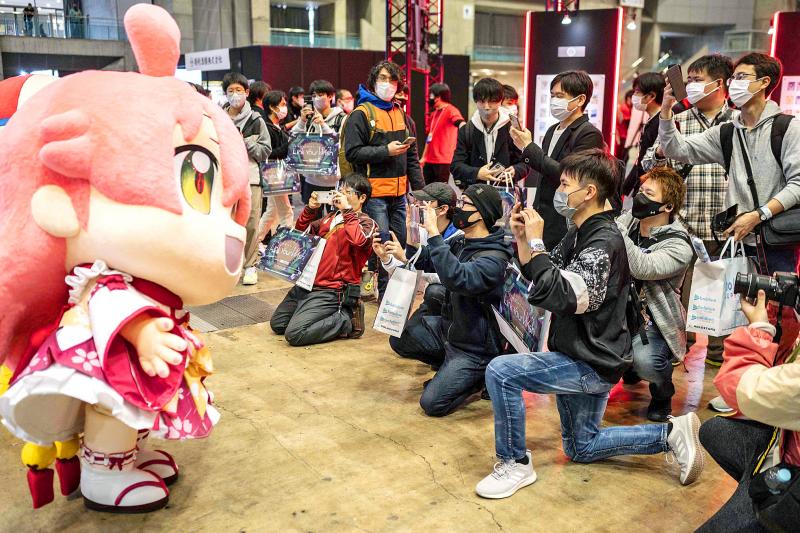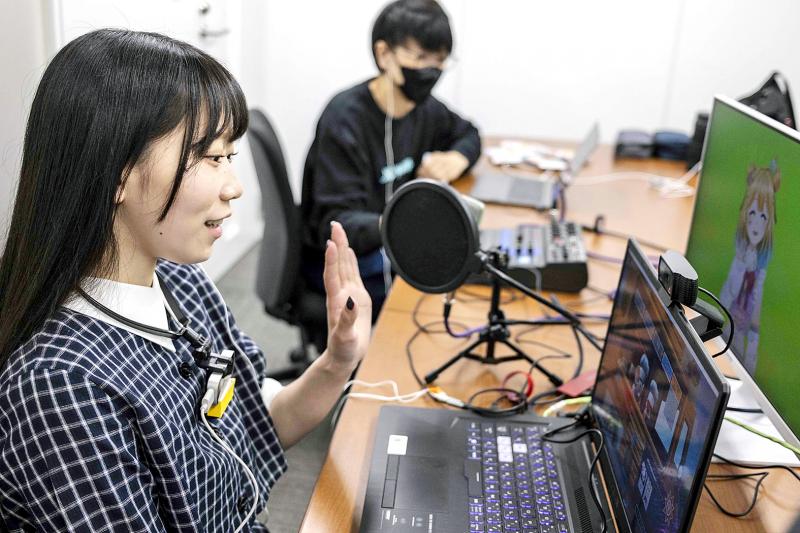Mayu Iizuka sheds her soft-spoken personality and starts cackling, screaming and waving wildly in a makeshift studio in Tokyo as her avatar appears on a livestream before hundreds of fans.
Virtual YouTubers such as Iizuka, who voices and animates a character called Yume Kotobuki, have transformed a niche Japanese subculture into a thriving industry where top accounts can rake in more than US$1 million a year.
The videos are designed to make fans feel they are interacting directly with their favorite animated idols — with viewers sometimes paying hundreds of US dollars to have a single comment highlighted on a livestream.

Photo: AFP
“When I’m playing video games on my channel and succeed at something, my fans congratulate me” and pay tips “as a way to show their support and appreciation,” Iizuka said.
The 26-year-old uses a laptop, Webcam and a motion sensor worn around her neck to appear on screen as Yume, whose facial expressions are controlled by a producer.
With her squeaky voice, short skirt and huge purple eyes, Iizuka’s avatar follows a popular model for “VTuber” characters, which often resemble the hyper-feminine heroines of Japanese anime.

Photo: AFP
Since emerging about five years ago, the VTuber world has grown quickly, with about 16,000 active streamers globally, data firm User Local said.
Fanbases are also growing on other platforms such as TikTok and gaming site Twitch.
Regional governments in Japan have used them for promotion, and The Batman stars Robert Pattinson and Zoe Kravitz even gave a recent interview to a top Japanese VTuber.

Photo: AFP
VTubers generate money in ways similar to traditional livestreamers, including through YouTube’s “Super Chat” system, where the more a fan shells out, the more attention is drawn to their comments.
The world’s nine top-earning YouTube accounts for “Super Chat” last year were all VTubers.
All nine are affiliated with one Tokyo-based talent agency, and each earned between US$700,000 and US$1.7 million from the cash gifts, data analysis Web site Playboard said.
Most fans spend only a few hundred yen per comment, but the most dedicated sometimes splurge ¥50,000 (US$383) to post impassioned missives to their virtual idols.
Kazuma Murakami, a 30-year-old auto parts inspector, has been known to spend ¥10,000 to get his comments highlighted in red and seen by his favorite VTuber.
“I really want her to notice I’m here again, visiting her channel,” Murakami said.
Another VTuber fan, who asked to be identified only by his first name, Kazumi, has adorned his tiny one-room apartment near Tokyo with posters, framed pictures and key rings featuring his favorite character, Mio Ookami.
The 30-year-old computer engineer spends time after work and on weekends immersing himself in Mio’s videos and crafting digital illustrations of the black-haired “wolf girl.”
“I dedicate five, or maybe 10 hours to thinking just about her,” he said. “She is like family to me.”
That devotion, and the willingness of fans to pay big money, is linked to the way other fan subcultures function in Japan, said Noriyuki Nagamatsu, a digital business specialist at advertising firm D.A. Consortium.
“Super Chat is essentially an extension of a longstanding culture where idol and anime fans try to support their oshi, or favorite, by splurging on their merchandise,” he said. “It’s also a way of winning attention from their beloved and feeling superior to fellow fans.”
VTubers usually keep the person behind the character — often referred to as their “soul” — out of the picture, and like many fans, Kazumi said his love is directed towards Mio the avatar, not whoever plays her.
However, the line between virtual and real can become blurred.
A Japanese court recently ruled in favor of a VTuber actor who said that online slander against her character amounted to an attack on her.
Virtual YouTubers can “transcend gender, age or physique ... but what’s important is that there’s a real person there who is speaking and reads the comments in real life,” said Kazuhito Ozawa, the plaintiff’s lawyer.
For Iizuka, a professional voice actress, making the rare decision to reveal her identity after four years of making videos as Yume was nerve-wracking.
“Part of me was afraid that fans of Yume, who has these big, shiny eyes and a perfect belly, might be disappointed to find out what the ‘real’ person inside looks like,” she said, adding that “so far the response from fans has been very kind.”
The more outspoken, vivacious personality of Yume’s virtual self is even gradually rubbing off on Iizuka, she said.
“I used to baulk at speaking publicly, but Yume is such an experienced livestreamer that my identity as her has been helping me speak more confidently,” she said.

CHIP RACE: Three years of overbroad export controls drove foreign competitors to pursue their own AI chips, and ‘cost US taxpayers billions of dollars,’ Nvidia said China has figured out the US strategy for allowing it to buy Nvidia Corp’s H200s and is rejecting the artificial intelligence (AI) chip in favor of domestically developed semiconductors, White House AI adviser David Sacks said, citing news reports. US President Donald Trump on Monday said that he would allow shipments of Nvidia’s H200 chips to China, part of an administration effort backed by Sacks to challenge Chinese tech champions such as Huawei Technologies Co (華為) by bringing US competition to their home market. On Friday, Sacks signaled that he was uncertain about whether that approach would work. “They’re rejecting our chips,” Sacks

NATIONAL SECURITY: Intel’s testing of ACM tools despite US government control ‘highlights egregious gaps in US technology protection policies,’ a former official said Chipmaker Intel Corp has tested chipmaking tools this year from a toolmaker with deep roots in China and two overseas units that were targeted by US sanctions, according to two sources with direct knowledge of the matter. Intel, which fended off calls for its CEO’s resignation from US President Donald Trump in August over his alleged ties to China, got the tools from ACM Research Inc, a Fremont, California-based producer of chipmaking equipment. Two of ACM’s units, based in Shanghai and South Korea, were among a number of firms barred last year from receiving US technology over claims they have

BARRIERS: Gudeng’s chairman said it was unlikely that the US could replicate Taiwan’s science parks in Arizona, given its strict immigration policies and cultural differences Gudeng Precision Industrial Co (家登), which supplies wafer pods to the world’s major semiconductor firms, yesterday said it is in no rush to set up production in the US due to high costs. The company supplies its customers through a warehouse in Arizona jointly operated by TSS Holdings Ltd (德鑫控股), a joint holding of Gudeng and 17 Taiwanese firms in the semiconductor supply chain, including specialty plastic compounds producer Nytex Composites Co (耐特) and automated material handling system supplier Symtek Automation Asia Co (迅得). While the company has long been exploring the feasibility of setting up production in the US to address

OPTION: Uber said it could provide higher pay for batch trips, if incentives for batching is not removed entirely, as the latter would force it to pass on the costs to consumers Uber Technologies Inc yesterday warned that proposed restrictions on batching orders and minimum wages could prompt a NT$20 delivery fee increase in Taiwan, as lower efficiency would drive up costs. Uber CEO Dara Khosrowshahi made the remarks yesterday during his visit to Taiwan. He is on a multileg trip to the region, which includes stops in South Korea and Japan. His visit coincided the release last month of the Ministry of Labor’s draft bill on the delivery sector, which aims to safeguard delivery workers’ rights and improve their welfare. The ministry set the minimum pay for local food delivery drivers at